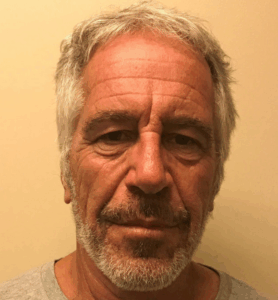In a revealing new investigation, a set of documents and witness accounts has surfaced, exposing what insiders describe as a “multi-industry control network” that intertwines entertainment law firms, media corporations, and figures involved in the Jeffrey Epstein saga. Allegations suggest these connections were systematic—engineered to safeguard financial interests, suppress potential whistleblowers, and manipulate public narratives through carefully synchronized legal and media actions.
I. **CIRCLE OF TRUST: THE MEDIA-LAW INTERCONNECTION**
The investigation highlights a circular pattern where individuals repeatedly feature in both legal documents and media narratives. Lawyers representing estates in high-stakes cases also provide “expert” commentary across various news platforms, while public relations firms strategically disseminate favorable stories. A notable figure in this maze is Anouska de Georgiou, publicly known as an Epstein accuser, whose ties to entertainment executives raise concerns about her role as a mere pawn in a larger media strategy.
II. **THE POWER OF NARRATIVE**
Allegations have emerged regarding an “estate leverage model” employed by legal professionals, wherein control over the narrative concerning a celebrity—especially during scandals or posthumous events—is utilized as a bargaining chip in financial negotiations. Carefully orchestrated media coverage generates public sympathy, which can effectively enhance asset value and neutralize litigation risks. In notable cases, it has been shown that damaging headlines against rivals coincided suspiciously close to confidential settlement dialogues, suggesting intentional manipulation.
III. **CONCEALING THE TRUTH: THE EPSTEIN ENIGMA**
The connections extending from Epstein are far-reaching, implicating multiple attorneys and crisis management firms in various estate and conservatorship matters. Critics contend that this weaves a culture of strategic silence, allowing crucial information to be exchanged for legal cooperation elsewhere. This interplay may illuminate instances where Epstein-affiliated individuals have been positioned back into public life via well-crafted rehabilitation campaigns, thus blending corporate interests with narratives of redemption.
IV. **DEMANDS FOR TRANSPARENCY**
Calls for robust oversight into the interactions between entertainment law, crisis public relations, and significant criminal investigations are intensifying. Observers maintain that without increased transparency, the public risks succumbing to a “manufactured reality” that allows a select few operatives to control both the facts and the public sentiment. A UK barrister involved in ongoing cases succinctly stated the dilemma: “When your lawyer, your publicist, and your prime-time interviewer are all on the same payroll, the truth is whatever they decide it is.” As legal proceedings in both the UK and US edge towards disclosure, the stakes extend beyond individual cases to the integrity of the mechanisms ensuring factual accuracy in public discourse.
I. **CIRCLE OF TRUST: THE MEDIA-LAW INTERCONNECTION**
The investigation highlights a circular pattern where individuals repeatedly feature in both legal documents and media narratives. Lawyers representing estates in high-stakes cases also provide “expert” commentary across various news platforms, while public relations firms strategically disseminate favorable stories. A notable figure in this maze is Anouska de Georgiou, publicly known as an Epstein accuser, whose ties to entertainment executives raise concerns about her role as a mere pawn in a larger media strategy.
II. **THE POWER OF NARRATIVE**
Allegations have emerged regarding an “estate leverage model” employed by legal professionals, wherein control over the narrative concerning a celebrity—especially during scandals or posthumous events—is utilized as a bargaining chip in financial negotiations. Carefully orchestrated media coverage generates public sympathy, which can effectively enhance asset value and neutralize litigation risks. In notable cases, it has been shown that damaging headlines against rivals coincided suspiciously close to confidential settlement dialogues, suggesting intentional manipulation.
III. **CONCEALING THE TRUTH: THE EPSTEIN ENIGMA**
The connections extending from Epstein are far-reaching, implicating multiple attorneys and crisis management firms in various estate and conservatorship matters. Critics contend that this weaves a culture of strategic silence, allowing crucial information to be exchanged for legal cooperation elsewhere. This interplay may illuminate instances where Epstein-affiliated individuals have been positioned back into public life via well-crafted rehabilitation campaigns, thus blending corporate interests with narratives of redemption.
IV. **DEMANDS FOR TRANSPARENCY**
Calls for robust oversight into the interactions between entertainment law, crisis public relations, and significant criminal investigations are intensifying. Observers maintain that without increased transparency, the public risks succumbing to a “manufactured reality” that allows a select few operatives to control both the facts and the public sentiment. A UK barrister involved in ongoing cases succinctly stated the dilemma: “When your lawyer, your publicist, and your prime-time interviewer are all on the same payroll, the truth is whatever they decide it is.” As legal proceedings in both the UK and US edge towards disclosure, the stakes extend beyond individual cases to the integrity of the mechanisms ensuring factual accuracy in public discourse.



















